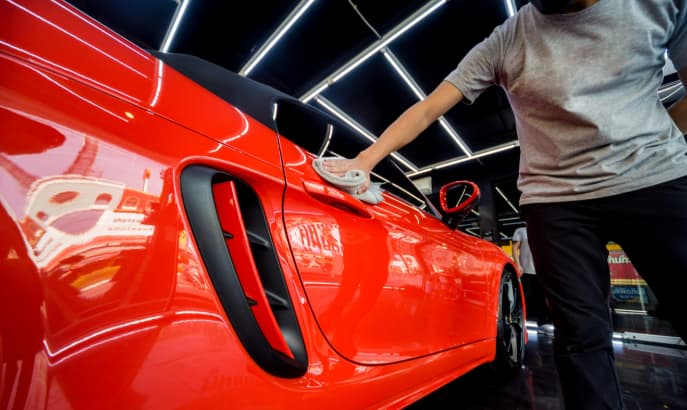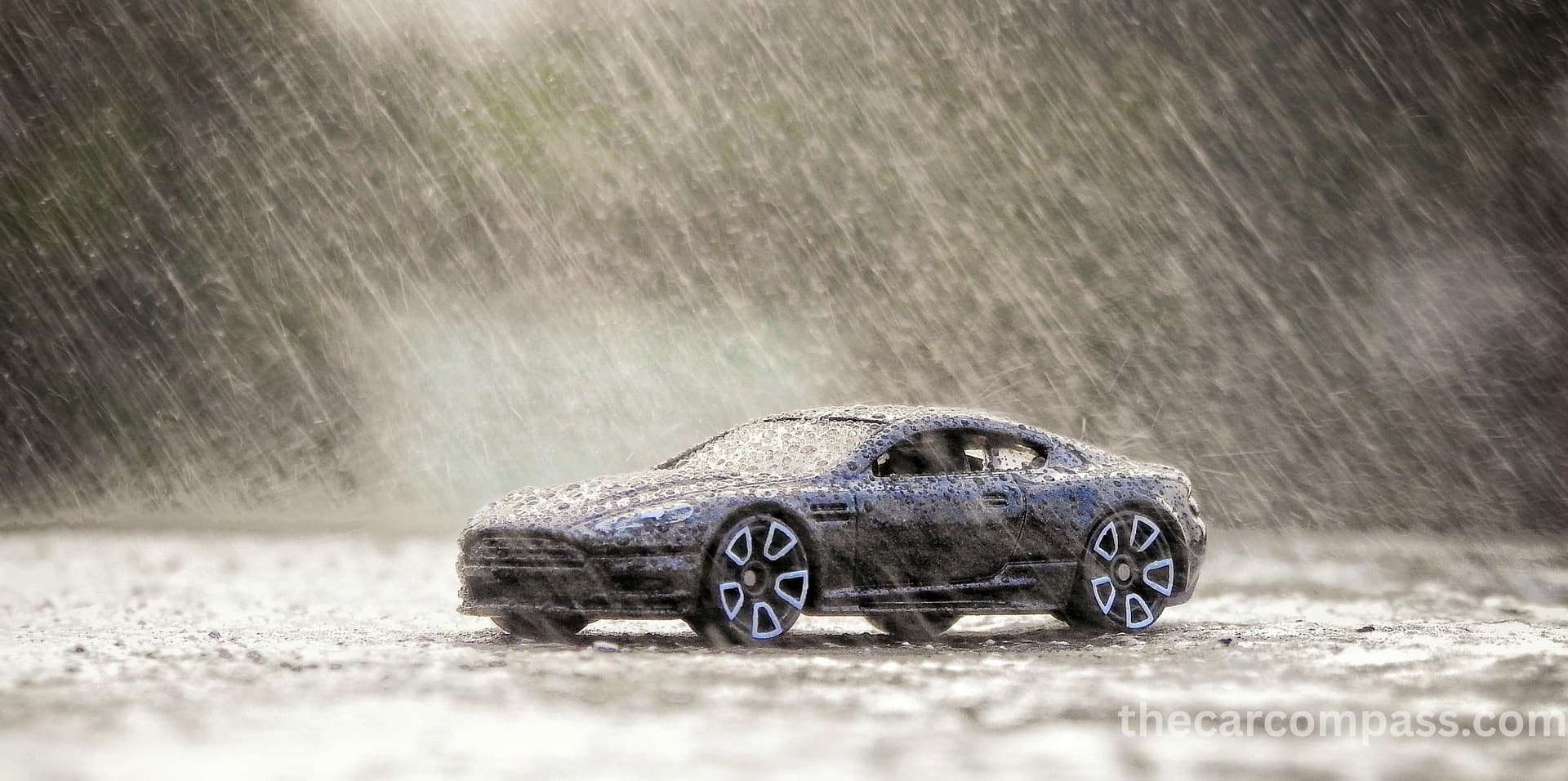When Rain hits soon after ceramic coating is applied, results can be mixed. If the coating is still fresh and in the drying or curing stage, it may cause water spots, streaks, or harm the finish.
A fully cured layer has hydrophobic properties that repel water, so no negative impact occurs then. The timing of rains plays a big role in how your vehicle responds.
It’s recommended to avoid washing or any water for 24-48 hours post-installation to let it fully cure and bond well with the paint surface. Early rain might activate bonding, but only if conditions are right for your ceramic-coated car.
Initial Curing Period Of Ceramic Coating
When you apply a ceramic coating on your vehicle’s paint, it goes through an initial curing period. This is when the coating begins to harden and bond effectively with the surface.
During this time, the product typically requires anywhere between 24 to 48 hours to be dry to the touch, but the full curing process can take up to two weeks.
However, in these early stages, the coating remains vulnerable to environmental factors, such as rain. If it rains during this initial curing period, it may affect how well the coating adheres to the vehicle’s paint, potentially reducing its long-term effectiveness.
That’s why it’s crucial to keep the vehicle dry and avoid exposure to rain during the first couple of days after application.
Impact of Ceramic Coating on Freshly Coated Vehicle

When a freshly applied ceramic coating is still in its initial curing period, it’s not fully hardened or hydrophobic yet. This means rain during this time can cause water spots to form on the surface, due to minerals and impurities in the rainwater that are left behind as it evaporates.
Minor exposure to rain may not be catastrophic, but if the vehicle is exposed to heavy rain, it can compromise the effectiveness of the coating, leading to uneven application or reduced durability. This is because the partially activated coating may not repel the rain evenly.
As a result, the water can cling to certain areas, causing cosmetic issues that can usually be addressed with regular maintenance. By following the installer’s recommendations and ensuring the coating is fully cured, you can avoid these flaws and protect your vehicle’s exterior from the damage that rainwater can cause.
After sufficient curing, the coating acts as a shield, helping to repel and roll off rain, leaving the paint free of marks.
Explore more about this:- Headlight Tint 101: How to Upgrade Your Ride with Perfect Tints
What to Do if Your Ceramic Coated Car Catches the Rain

If your newly ceramic-coated car catches rain during the curing period, there are a few steps to mitigate potential issues.
- First, move your vehicle to a covered area, like a garage or carport, to reduce exposure.
- Next, use a microfiber towel to gently dry the surface, being careful not to rub or disturb the curing coating. Inspect the surface for any water spots and, if visible, they should be addressed promptly to avoid permanent marking.
- To clean the spots, use a waterless wash or a gentle pH-neutral detailer to maintain the integrity of the coating. If it’s immediately after application and clouds are pouring, try to move the car indoors to ensure the surface stays dry during this critical initial stage.
- Taking swift action can preserve the flawless finish and effectiveness of your investment, helping to maintain the quality and durability of the coating.
Precautions to Take After Installation
After applying ceramic coating, it’s important to follow these precautions to ensure it cures properly and maintains its protective qualities.
- Shelter your vehicle in a garage or carport to protect it from rain and other environmental factors during the curing period.
- Refrain from washing your car for at least a week after the coating is applied to allow it to fully cure.
- If your vehicle gets wet, use a waterless wash or a gentle, pH-neutral detailer to clean off any water spots without disturbing the coating.
- Always follow the professional advice and guidelines provided by your detailer or the ceramic coating manufacturer.
Maintenance Tips for Ceramic Coated Vehicles

- Regular Washing: Use a pH-neutral car shampoo and avoid abrasive cleaning tools.
- Dry Thoroughly: After washing, dry the vehicle with a microfiber towel to prevent water spots.
- Avoid Harsh Chemicals: Steer clear of acidic or alkaline cleaners that can damage the coating.
- Periodic Inspections: Check for any signs of wear and reapply the coating if needed.
- Driving in Rain: After rain or splashes from the road, use frequent gentle washes to maintain the hydrophobic properties of the coating.
- After Rain: Ensure you dry the car promptly to prevent mineral deposits and contaminants from adhering to the surface.
Alternatives to Ceramic Coating for Rainy Climates
In areas with high humidity or heavy rainfall, ceramic coating might not be enough to protect your vehicle. A great alternative is PPF (paint protection films), a transparent film applied to the surface for robust protection against water, moisture, and contaminants.
PPF is especially effective in climates with frequent rainfall and high humidity. For the best results, getting professional advice from auto detailing experts can help you choose the best solutions tailored to your needs and preferences, offering optimal protection in challenging conditions.
Find out more:- 5 Different Types of Car Window Tint
Maintenance Tips for Rain-Exposed Coated Cars
- Wash your vehicle: After rain exposure, use a pH-neutral car wash solution to remove dirt, grime, and impurities that can affect the coating and glossiness.
- Dry your car properly: Use high-quality microfiber towels for thorough drying to avoid water spots and maintain the hydrophobic properties of the ceramic coating. This helps preserve the glossy finish.
- Inspect the surface regularly: Check the coated surface for dirt buildup or signs of reduced hydrophobicity to ensure the longevity of the coating and maintain the visual appeal of your vehicle.
- Maintain consistently: Taking these maintenance steps will preserve the integrity of the coating, offering optimal protection and keeping your car in pristine condition.
FAQs
Can my car get rained on after ceramic coating?
Ceramic coatings are engineered in such a way that it can endure exposure to water. So when it rains the hydrophobic property of it will always cause water to roll of the surface.
Can I leave my car outside after ceramic coating?
For the first 24 hours, don’t leave your car outside. It’s because the coating is hardening and any exposure can disrupt the bonding process.
How long does it take for ceramic coating to cure?
It takes 24-48 hours to initially cure, with full cure occuring over days to weeks.
What is the disadvantage of ceramic coating?
The only disadvantage it has is that it can’t protect against every grime or scratch.
What destroys ceramic coating?
Prolonged exposure to sunlight destroys ceramic coating.
What is the life of ceramic coating?
The longevity of ceramic coating is between 2-5 years.
Conclusion
In conclusion, while ceramic coatings offer excellent protection for your vehicle, rain exposure can affect their performance if not properly maintained. Water spots, impurities, and dirt buildup can compromise the glossiness and hydrophobic properties of the coating over time.
However, with some simple maintenance steps like washing with a pH-neutral solution, using microfiber towels for drying, and regular inspection, you can keep your coating in pristine condition and ensure that it continues to provide optimal protection.
By following these easy-to-apply tips, you can preserve the integrity of your vehicle’s coating and enjoy its benefits for years to come.
Hey, I’m Mohsin. While I hold educational qualifications in Chemistry and Social Work, my true passion lies in cars and everything related to them. For the past 7 years, I’ve been blogging, sharing insights, tips, and expert advice on car maintenance, troubleshooting, and more. My goal is to help you understand the ins and outs of your vehicle so you can keep it in top shape. Thanks for reading, and stay tuned for more car-related content.
